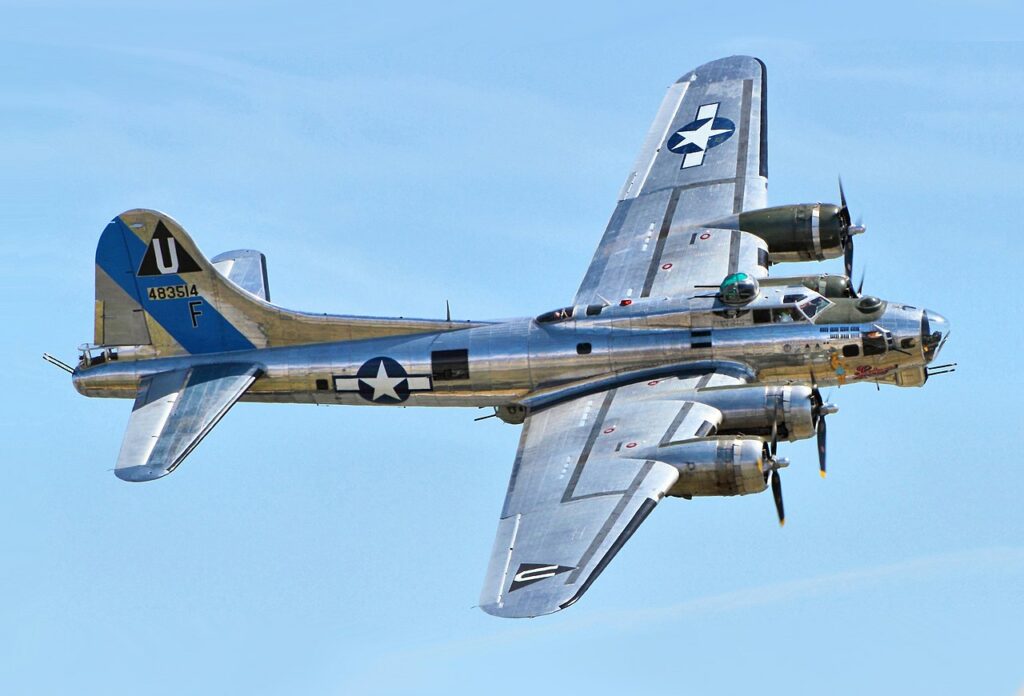Operators of flying examples of the iconic Boeing B-17 ‘Flying Fortress’ are awaiting the issue of an FAA mandatory Airworthiness Directive (AD) in coming weeks, which may impact the viability of flying operations.
One B-17 operator has already suspended flying operations as a precautionary measure, ahead of the proposed structural AD, which relates to the aircraft’s wing mount/attachment assembly.
The proposed AD and its implications
The aircraft, which is perhaps best known for the critical role it played in the US Army Air Force daylight bombing campaign in the European theatre of war during the 1940’s, is facing a new challenge in 2023.
The problem, stated quite simply, is one we will all ultimately face – old age. In its wartime role, the iconic four engine bomber developed a reputation amongst flight crews for its ability to remain airborne despite sustaining significant structural damage.
With the airframes now well over half a century old, problems of structural integrity and fatigue have become the order of the day.
An Airworthiness Directive was previously issued by the FAA calling up inspections to detect cracking and corrosion of the wing spar chords, bolts and bolt holes.

[monsterinsights_popular_posts_inline]
The forthcoming FAA AD appears to relate to wing/fuselage attachment assembly and may have arisen from problems which were encountered on ‘Aluminium Overcast’ – the B-17 owned by the Experimental Aircraft Association.
That aircraft was grounded in April 2021, when wing spar problems were detected during maintenance.
The significance of the forthcoming AD is that the current airworthy aircraft will be grounded until the maintenance actions specified by the Directive can be accomplished.
‘Yankee Lady’ flight ops suspended
Of the three flying B-17’s in the US, ‘Yankee Lady’ owned by the Yankee Air Museum has already speculatively ceased flight operations ahead of the proposed AD.

On their recent Facebook post, the Air Museum cited “wing spar issues” as the concern, stating:
“The Yankee Air Museum decided to proactively cease flight operations of the B-17G Flying Fortress ‘Yankee Lady.’”
“Recent inspections of other B-17s have discovered wing spar issues. As a result, we expect a mandatory Airworthiness Directive to be issued by the FAA in the next few weeks regarding the matter.”
“Out of an abundance of caution, we are temporarily ceasing our B-17 flight operations and awaiting direction from the FAA regarding necessary inspections and repairs that will be required.”
“It is expected that the B-17 will not fly during the 2023 flying season.”
As well as the three flying examples in the United States, the FAA AD will also likely affect ‘Sally B’ – the B-17 operating out of Duxford.

Service life
The expected service life of the Boeing B-17 Flying Fortress when it was first built was not officially defined, as it was designed and built specifically for military use during World War II.
The primary goal was to create a heavy bomber that could operate at high altitudes, defend itself from enemy fighters, and carry a large bomb load over long distances.
Flying in large box formations to provide protective cover, the B-17 Flying Fortresses were exposed to heavy anti-aircraft fire as well as marauding fighter aircraft.
B-17’s were known to return to England with multiple engine failures in major structural damage including missing vertical stabilisers.

The B-17 was first introduced in 1938, and during the war, it was heavily utilized by the United States Army Air Forces and the Royal Air Force for strategic bombing missions.
Despite being vulnerable to enemy fire, the B-17’s durability and reliability allowed it to remain in service for the entire duration of the war.
Overall, the actual life expectancy of a B-17 during wartime was heavily dependent on a number of factors, including the frequency of combat missions, the conditions in which it was flown, and the maintenance and repair efforts of ground crews.
Some B-17s managed to survive more than 100 missions, while others were lost much earlier.
At the height of the aerial offensive over Germany, the life expectancy of bomber crews and aircraft was typically measured in weeks and months.
Whilst there was no officially defined service life, we can safely presume the Boeing B-17 certainly wasn’t expected to be airworthy and flying all these decades later!









